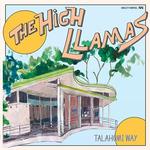|
|
 |
Dusted Reviews
Artist: The High Llamas Album: Talahomi Way Label: Drag City Review date: May. 26, 2011 |

|
|
|
 |
One of pop’s great historicizing claims is the re-evaluation of a pop musician to an artisan creative: the hysterical flash in the pan (cf. T. Rex) becomes, through time, not just a cultural barometer but an exalted artist. It’s always been an intriguing way of dealing with not just the meaning of the pop song, but its socio-cultural impact as well, the way one song brings a world to bear upon it.
So when we’re faced with an artist like Sean O’Hagan, who has spent a good two decades reminding us that pop in its most exalted sense is one of the purest art forms around, it’s easy to lapse into comparative analysis or lists of influences. I’d previously sworn never to mention The Beach Boys again while writing about O’Hagan’s main squeeze, The High Llamas, but the comparison is only instructive these days by what it leaves out – pinging O’Hagan as a Brian Wilson imitator ignores the way he’s become a tireless researcher, much like his comrades Stereolab. Both treat the history of music as a field of possibility, and understand that their simple twist on modernism’s endless "making new" – retro-futurism, to be almost shamefully reductive – doesn’t mean they’ve given in to the shallow ides of post-modernism.
So with Talahomi Way, you can hear O’Hagan’s inspirations, like Basil Kirchin or Carla Bley, in the subtle experimentation of the arrangements, the way strings and brass lever songs onto another plane, or the endless permutations of the title song’s instrumental coda: imagine if the entire High Llamas cabal were in a flick-book, and a child was flipping through the pages in discrete segments, each turn unlocking a new twist to flesh out a simple, breezy chord change. Indeed, the focus on Talahomi Way seems to be an expanded group sound, an extension on the soul and R&B moves they toyed with on 2007’s Can Cladders. But it’s not just about reeling off the precursors, or ticking off genres. As in all of their other records, there’s a community of sound at play here, a benevolent nurturing of arrangements and noises that I suspect reflects the world O’Hagan wants to live in.
“Fly Baby, Fly” feels like a sequel to Can Cladders’ “The Old Spring Town," with both songs lyrically based around the day-to-day realities of performance and theatre, exchanging “Town”’s disenchanted promoter with Berry Adams, the car mechanic turned itinerant guitar player who provides the narrative thread to Talahomi Way. Both songs are upful, gently stomping things, bright on the upbeat with the Llamas playing in gleeful consort. But Talahomi Way’s most compelling moment is “Ring Of Gold," a bewitching tale about a racing horse in retirement. O’Hagan compassionately details the animal’s newly peaceable life to one of his most poised and beautiful melodies yet, guided by strings and flute that dapple the corners of the room with light, while a harp sends flourishing trills out into the air.
As with the last few High Llamas albums, Talahomi Way is as much about the lyrics as the melodies, and here again O’Hagan draws on flora and fauna, building and architecture, travel and migration, and itinerant artists making their way through the day, to tell an unfussy story of the warmth of the commonplace. (For some reason, this also resonates with ’60s/’70s British folk – I am left thinking of Vashti Bunyan’s pilgrimage to the Isle of Skye, or the Incredible String Band’s retreat to Glen Row.) And like Beet Maize And Corn (2004) and Can Cladders, it features artwork by Jeremy Glogan, painting what looks to be a modernist, utopian beachside venue with curving roof and rails, and open-to-the-world glass walling. Much like the album it houses, it’s free and welcoming, and idiosyncratic without being noisy about its "difference." This strikes me as nicely analogous to The High Llamas’ greatest achievement: their ongoing, articulate and subtle working of avant-gardism into effortlessly essayed pop songs. It’s a body of work that begs deep listening, the better to divine the wild kindness at its core.
By Jon Dale
|







